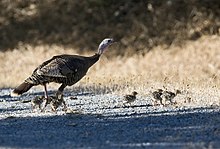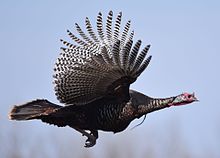Turkey
| Turkey | ||||||||||
|---|---|---|---|---|---|---|---|---|---|---|

Turkey |
||||||||||
| Systematics | ||||||||||
|
||||||||||
| Scientific name | ||||||||||
| Meleagris gallopavo | ||||||||||
| Linnaeus , 1758 |
The wild turkey ( Meleagris gallopavo ) is in North America -based nature of the turkeys . It is also called wild turkey or wild turkey and is the largest species of chicken bird . It was already domesticated by Indian peoples and is therefore the ancestral form of the domestic turkey , the turkey .
features
When standing, adult turkeys reach a height of 1 m and a weight of 10 kg. Hens are slightly smaller (90 cm) and much lighter (4 kg). The plumage is dark brown and black and has a metallic sheen, especially on the rooster. The neck and head are not feathered. The part of the face and the parting are light blue, the neck and throat are pale red. A red flap of skin, which is 6 to 8 cm long, arises in the cock between the eyes and hangs across the beak. All roosters and 10% of the hens also have a bristle-like plume on their chest that is 10 to 25 cm long.
During the breeding season, the colors of the bare parts of the body become brighter and can also change so that they then become white or turquoise. Turkeys can live to be ten to twelve years old.
distribution and habitat
The distribution area extends from the southern edge of Canada over the USA to the north of Mexico . Turkeys are wild in three Canadian provinces, 49 US states, and six Mexican states. In the USA it is only missing in Alaska; it did not occur naturally in Hawaii, but it was introduced by humans. Wildlife populations also exist in Australia and New Zealand.
The habitat is forests with dense undergrowth and large clearings.
Settlements in Europe
In Central Europe settlements came over several decades, but the populations always had to be supported by relief measures. In Lower Austria there were larger breeding populations between 1880 and 1940, which comprised several hundred individuals, but which quickly collapsed after the cessation of the Hege in the Second World War. A resettlement failed, as did the eleven attempts to bring turkeys to Germany between 1953 and 1993. A settlement in the Upper Rhine area reached a maximum population of 300 individuals, but in 1997 there were only 12 individuals. In the Wesel district there were 200 to 250 individuals in the 1960s, but in 1977 only one male and four or five females lived. The largest free- living Central European population is in the Czech Republic , where there were 530 individuals in 1988.
The earliest mention of resettled turkey populations in Germany describes the period from 1698 to 1732. However, it has not been established whether these were wild turkeys or domesticated animals.
Settlements in other regions of the world
Tasmania and Australia
On the Tasmanian island of King Island , which lies at the western end of the Bass Strait between Tasmania and Australia and has an area of 1,098 km², there was a semi-wild group of turkeys in the 1990s, which was kept by a few farmers and more than 350 Individuals included. On the Furneaux Group , one consisting of 52 islands archipelago at the eastern end of Bass Strait between the Australian states of Victoria and Tasmania, 20th Century turkeys were exposed in the first half and had already firmly established in the year 1950th A particularly large number can be found on Flinders Island , the largest island in this group. However , the turkeys released on Kangaroo Island , which have been living free there since 1950, must be supported by aid measures. The turkeys living on Garden Island (Western Australia) , which established themselves there as captive refugees on a turkey farm in the 1940s, became extinct again in the 1950s.
New Zealand
Attempts to settle in New Zealand were made in the 19th century. These were wild turkeys from Mexico that were brought to New Zealand via Great Britain. The settlement attempt was ultimately unsuccessful, but further settlement attempts followed in the 1920s and 1950s, so that today turkeys are common on New Zealand's North Island . Some farmers also tend them as semi-wild groups.
Way of life
Since the way of life is largely the same as that of the related peacock turkey, this is described in the article turkeys .
Cultural meaning

The turkey was already of paramount importance for the Indian population . Before the arrival of the Europeans, several tens of millions of turkeys lived in North America, in some places with a density of 80 individuals per km². Indians mainly used the meat, but also the feathers for clothes, jewelry and the fletching of arrows . After the white-tailed deer , the turkey was the most widely used animal for the American Indian population.
There were domestic turkeys in the southwest of what was later to become the United States and in Mexico. The domestication probably occurred more than 2000 years, at the latest at the time of Late Präklassik by the Maya . The Indians of the north and east, however, did not domesticate turkeys.
Even the conquistador Hernán Cortés brought domestic turkeys to Spain after his campaign against the Aztecs. From there they spread all over Europe. The Europeans, who later colonized North America, brought turkeys back again, so that many domestic turkeys in the northern United States are likely to go back to ancestors who lived in Europe.
At Thanksgiving the turkey is the traditional dish in the United States and Canada.
Threat and protection
The several million populations of wild turkeys suffered a complete collapse after the colonization of North America by the Europeans. This was due to the increasing deforestation and expansion of agricultural monocultures, but above all to the rampant hunting of animals. By the late 1940s there were only about 130,000 turkeys left in all of North America, mostly hiding in mountain and swamp forests.
From 1960, the turkey's situation improved. This was due to effective conservation efforts and a growing rural exodus of the population; Farms were abandoned and then overgrown with shrubbery, making them suitable turkey habitats. In 1990 there were 3 to 5 million turkeys again.
Names
For etymology and other names, see turkeys .
Others
In the 1950s, targeted attempts were made in captivity with females of a certain breed ("Belts-ville Small White") to produce offspring through parthenogenesis (virgin generation). In 1952 a development could be determined in 16.7% of the parthenogenetically produced eggs, by 1959 this rate could be increased to 41.7%. Of a total of more than 42,000 parthenogenetically produced eggs, 67 (0.16%) hatched. However, only a few of these chicks survived to sexual maturity. The offspring created in this way are all male, as they arise from the duplication of haploid cells . The resulting cells can only carry the combination WW or ZZ of the sex-determining chromosomes W and Z in birds , of which only the variant ZZ (= male sex) is able to survive.
Subspecies
Six subspecies of the turkey are commonly recognized:
- Meleagris gallopavo silvestris Vieillot , 1817. Eastern subspecies. Eastern USA and Southeast Canada.
- Meleagris gallopavo osceola Scott , 1890. Florida subspecies
- Meleagris gallopavo intermedia Sennett , 1879. Rio Grande subspecies. United States and Northern Mexico east of the Gulf of Mexico
- Meleagris gallopavo merriami Nelson , 1900. Merriams subspecies. Southwestern USA, east of intermedia
- Meleagris gallopavo mexicana Gould , 1856. Gould's subspecies. Pacific Coast Region of Northern Mexico
- Meleagris gallopavo gallopavo Linnaeus , 1758. South Mexican (type) subspecies.
According to genetic analyzes, the subspecies, which are primarily based on color characteristics, can be genetically differentiated from one another, with the exception of the Florida subspecies, which therefore belong to the eastern subspecies.
Individual evidence
- ↑ Hans-Günther Bauer, Einhard Bezzel and Wolfgang Fiedler (eds.): The compendium of birds in Central Europe: Everything about biology, endangerment and protection. Volume 1: Nonpasseriformes - non-sparrow birds , Aula-Verlag Wiebelsheim, Wiesbaden 2005, ISBN 3-89104-647-2 , p. 163
- ^ Heinrich Spittler: Naturalization attempts with wild turkeys (Meleagris gallopavo L.) in the Federal Republic of Germany and their current occurrence . In: Journal for Hunting Science . tape 39 , no. 4 , 1993, p. 246-260 , doi : 10.1007 / BF02241399 .
- ↑ a b c Higgins (Ed.): Handbook of Australian, New Zealand & Antarctic Birds . Volume 2, p. 355.
- ↑ Thornton et al. 2012. Earliest Mexican Turkeys (Meleagris gallopavo) in the Maya Region: Implications for Pre-Hispanic Animal Trade and the Timing of Turkey Domestication . PLoS ONE 7 (8): e42630; doi: http: //dx.doi.org/10.1371/journal.pone.0042630
- ↑ Stephen W. Eaton: Wild Turkey (Meleagris gallopavo) in A. Poole (ed.): The Birds of North America Online Ithaca, Cornell Lab of Ornithology 1992, doi: 10.2173 / bna.22 , section "Demography an Populations"
- ^ MW Olsen: The occurrence and possible significance of parthenogenesis in eggs of mated turkeys . In: Journal of Genetics . Vol. 58, No. 1 , 1962, ISSN 0022-1333 , pp. 1–6 (English, online [PDF; 542 kB ]).
- ^ IOC World Bird List Pheasants, Partridges & Francolins
- ↑ Louis Pierre Vieillot, p. 447.
- ^ William Earl Dodge Scott, p. 376.
- ↑ George Burritt Sennett, p. 428.
- ^ Edward William Nelson, p. 120.
- ^ John Gould, p. 61.
- ↑ Carl von Linné, p. 156.
- ^ Mock, KE, Theimer, TC, Rhodes, OE, Greenberg, DL, Keim, P. (2002): Genetic variation across the historical range of the wild turkey (Meleagris gallopavo). Molecular Ecology 11: 643-657. doi: 10.1046 / j.1365-294X.2002.01467.x
literature
- John Gould: On a new Turkey, Meleagris mexicana . In: Proceedings of the Zoological Society of London . tape 24 , no. 304 , 1856, pp. 61–63 ( online [accessed February 11, 2015]).
- Josep del Hoyo et al .: Handbook of the Birds of the World. Volume 2: New World Vultures to Guinea Fowl. Lynx Edicions, 1994, ISBN 84-87334-15-6 .
- Carl von Linné : Systema Naturae per Regna Tria Naturae, Secundum Classes, Ordines, Genera, Species, Cum Characteribus, Differentiis, Synonymis, Locis . 10th edition. tape 1 . Imprensis Direct Laurentii Salvii, Stockholm 1758 ( online [accessed February 11, 2015]).
- Edward Avery McIlhenny: The Wild Turkey and its Hunting. Doubleday, Page & Company, New York 1914.
- Edward William Nelson : Description of a New Subspecies of Meleagris Gallopavo and Proposed Changes in the Nomenclature of Certain North American Birds . In: The Auk . tape 17 , no. 2 , 1900, p. 120–126 ( online [PDF; 314 kB ; accessed on February 11, 2015]).
- William Earl Dodge Scott: Description of a New Subspecies of Wild Turkey . In: The Auk . tape 7 , no. 4 , 1890, p. 376–377 (English, online [PDF; 85 kB ; accessed on February 11, 2015]).
- George Burritt Sennett, Elliot Coues: Further Notes on the Ornithology of the Lower Rio Grande of Texas, from Observations made during the Spring of 1878 . In: Bulletin of the United States Geological and Geographical Survey of the Territories . tape 5 , no. 3 , 1879, p. 371-440 ( online [accessed February 11, 2015]).
- Louis Pierre Vieillot: Nouveau dictionnaire d'histoire naturelle, appliquée aux arts, à l'agriculture, à l'économie rurale et domestique, à la médecine, etc. Par une société de naturalistes et d'agriculteurs . tape 9 . Deterville, Paris 1817 ( online [accessed February 11, 2015]).
Web links
- Meleagris gallopavo in the endangered Red List species the IUCN 2008. Posted by: BirdLife International, 2008. Accessed January 31 of 2009.
- Videos, photos and sound recordings of Meleagris gallopavo in the Internet Bird Collection
- Videos on Meleagris gallopavo published by the Institute for Scientific Film . Provided in the AV portal of the technical information library .
- Turkey feathers



